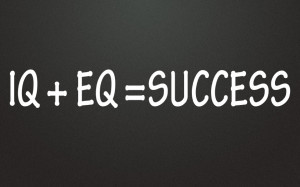Mary E. Marshall's Blog, page 40
June 25, 2014
Leadership Puzzler: Is it a Marketing Problem or a Sales Problem?
 Marketing means so many things to so many different people that it’s hard to pin it down. In many ways, it’s a misunderstood discipline, so when one of my clients kept saying, “we need more marketing,” I finally sat him down and asked, “what does that mean to you?” His answer was, more sales.
Marketing means so many things to so many different people that it’s hard to pin it down. In many ways, it’s a misunderstood discipline, so when one of my clients kept saying, “we need more marketing,” I finally sat him down and asked, “what does that mean to you?” His answer was, more sales.
This is the common misconception regarding the distinction between the two. Marketing is research, design, solving a need, and telling the story. Sales is closing the deal. So I asked him, “which is the problem?” He said that in fact it was marketing because he needed leads and needed to know how to position the company more effectively. He was intent on hiring “a person” to do the marketing, which in his mind meant cold calling. I explained that this was not necessarily marketing and may or may not be what he needed.
I asked if he had previous success with outbound cold calling before and the answer was no. So again, I asked, “what do you need?” Long story short, when we finished the conversation he agreed that indeed he needed marketing, but not the kind he thought. What he needed was someone to come in and manage the brand, create a great story, and offer several ways to start making the phone ring. He already had good sales people, but they needed leads to augment what they were already doing.
Most smaller companies, (like the one in this story), are not able to afford a talented marketing professional full-time, nor is it what they need. What we ended up doing to solve his problem is find an outside resource as an interim marketing director for 2 days a week. She came in, assessed the problem and the need, and put together a marketing strategy in a matter of days that was executable and that started working by the end of the first month. She had multiple resources to call upon to get the various tasks done. For a small business, her level of expertise and knowledge was a huge win and he would never have been able to afford her full-time. He now has her one day per week and the sales team has never been happier with all the incoming leads.
The moral of the story is make sure you walk through the need or problem you are solving in depth. Because it can be complex, and hard to see from an insider’s perspective, it can be very helpful to have someone like a coach to work with. The solution is out there, it may just be in a different package then you first envisioned.
photo credit: ntr23 via photopin cc
The post Leadership Puzzler: Is it a Marketing Problem or a Sales Problem? appeared first on Mary Marshall // CEO Coach.
What Is Your Company “The Best” At?
 When people talk about “marketing,” they often get focused on one aspect, such as “branding.” However, marketing is so much more than that. There are literally more than a hundred different aspects of marketing and specialists in each. So it’s not just about the branding, it’s about the whole story. And before the story, it’s about the research into what the customer needs and wants. Figuring out what you do best to solve the need and creating a compelling story around it, with a strategic and tactical plan including all aspects of marketing which will cause someone to “want” to buy your product or service.
When people talk about “marketing,” they often get focused on one aspect, such as “branding.” However, marketing is so much more than that. There are literally more than a hundred different aspects of marketing and specialists in each. So it’s not just about the branding, it’s about the whole story. And before the story, it’s about the research into what the customer needs and wants. Figuring out what you do best to solve the need and creating a compelling story around it, with a strategic and tactical plan including all aspects of marketing which will cause someone to “want” to buy your product or service.
When I work with small to mid-sized companies they often say “we need marketing” without any real idea what that means. A marketing consultant will come along and do a beautiful rebrand, (which is where they usually start), and then leave behind a new look and feel, but the company doesn’t know how this will or should translate into sales, and whole marketing budget has been spent in the process. What usually happens next is the company says “well, that was a waste of time” and then slashes the marketing budget to almost nothing and moves on.
Where I usually start when talking with a company that recognizes they have a marketing challenge is, what story are you trying to tell? What is it that only you do? Or that you do better than anyone else? What about how you solve a problem is unique to you? Good customer service is NOT it. Everyone can say they have excellent customer service or a superior product, (why would you say otherwise), but few really can pick what it is that they do that is unique. If you can identify this, with one of the four standard “positions,” – Best, Most, Only or First – (described in depth in this month’s free chapter download from Putting Together the Entrepreneurial Puzzle), and tell the story around that, you have half the battle won. This is your unique story. You do not want to be like everybody else. You want to be the solution to the problem and that will make customers buy your product or service vs. someone else’s.
Once this story is written, is compelling, and you have branding to match, then you can move on to all the other aspects of marketing. What really helps is to have a Marketing Director, (inside or outsourced), that can make all the appropriate resources available to you e.g., web designers and developers, PR professionals, email marketing specialists, social media specialists, etc. You will usually not need any of these people on a full-time basis, what you need is someone who can mange the “project” of marketing for your company. A good marketing project manager will pull the levers and find the talent you need to implement the right solution at the right time.
Your job as CEO is to find this talent and get out of the way. Don’t scrimp on the marketing budget, (it’s like going to Wal-Mart when you need to look like Sak’s 5th Avenue), and be sure to keep the big picture of marketing focused on telling the story of what your company does best, and why.
The post What Is Your Company “The Best” At? appeared first on Mary Marshall // CEO Coach.
June 19, 2014
Mid-Year Strategy and Goal Review
 Yes, it’s that time of year when you drag out and dust off those pesky goals, the strategic plan and assess how it’s going. The companies that review every 90 days are much more likely to achieve their goals than those that don’t.
Yes, it’s that time of year when you drag out and dust off those pesky goals, the strategic plan and assess how it’s going. The companies that review every 90 days are much more likely to achieve their goals than those that don’t.
Why do we resist this? I think it has to do with the fact that things are moving so fast these days. What was important yesterday, a week ago, a month ago, may no longer seem as important as it once did. It’s also hard to face things we haven’t accomplished yet.
So rather than hold beliefs about what it means when you don’t accomplish something that was on your list, let’s reframe and focus on what you did accomplish and do the oil change on what you need to adjust that is still on the list. Remember that the items on your “goal” list are just items which have differing levels of importance. The only thing it means when you don’t accomplish something is just that – it didn’t get done. It doesn’t mean you are a slacker, a bad person or incapable of accomplishing goals. We attach meaning to accomplishments or the lack thereof – beating yourself up is not helpful and won’t change the way things are. It’s just time to reframe and move forward.
When you review your strategy, start out with an honest assessment of where you are. What’s working? What’s not working? What facts do you now have that you didn’t have when you created it? Based on your progress, how likely is it to be accomplished in the time frame allotted? Be honest about your answers and come up with either a new time frame, or incorporate the other “facts” you now know about to inform and influence a successful outcome. Maybe you are missing a key resource or talent. Now is the time to get them on the team to accomplish the strategy or goals.
It’s completely okay to change or abandon a strategy or design a new way of getting there. There is nothing so foolish as to continue on a plan that is no longer important to the organization or the individual. Some consider this to be “giving up.” I don’t. I consider it making a better decision given the “new” set of circumstances. As Maya Angelou would say, “when you know better, you do better.” If you look at any of the Agile or Lean processes, they are always about “review” and “reinvent.” So why don’t we apply this to our strategic process and our goals? Habit. And without a replacement for how we might approach it, the habit just keeps hold of the process. So it’s time to change the habit with a new way of doing things.
Start with reviewing your strategies and goals as a leader. Decide what’s working, what’s not and make adjustments. Do a rewrite and this time review after 90 days to make course corrections vs. waiting for 180 to pass. Once you’re finished with your personal goals, review the company strategy, and then help your team with theirs. Leadership means you get to go first.
photo credit: duncan via photopin cc
The post Mid-Year Strategy and Goal Review appeared first on Mary Marshall // CEO Coach.
June 12, 2014
Culture and Employee Satisfaction
 I’ve talked a lot about how to create an intentional culture and why it’s important to the success of your business – aligning values, living them on a daily basis, and at the heart of it all, making your employees feel as if they are a part of something that matters – are the key components.
I’ve talked a lot about how to create an intentional culture and why it’s important to the success of your business – aligning values, living them on a daily basis, and at the heart of it all, making your employees feel as if they are a part of something that matters – are the key components.
So when I read the recent article in the NYT regarding employee satisfaction, or rather the large percentage of employees who are dissatisfied, I was interested. Especially in light of the fact that the author, Tony Schwartz, listed 6 easy ways you can turn the feeling of dissatisfaction around, thus creating a much more cohesive, intentional and therefore more productive culture.
Here are his 6 easy steps for companies both large and small:
Respect and hold the value of every person who works for you, because nothing matters more.
Start measuring people by the value they create, not by the number of hours they work.
Support, encourage and reward people for not responding constantly to email, and even for turning it off entirely at selected times, to get their most challenging and important work accomplished. Concentration serves excellence.
Help people build more renewal into their lives, on and off the job. The greater the demand for performance, the greater the need for renewal.
Actively focus on making people’s jobs matter more. Help them to define their work — whatever it is — in a way that allows them to do more of what they do best
The way you behave every day makes a far stronger statement than anything you can ever say.
What I really like about these 6 steps is they are easy. It doesn’t take a program, an initiative, or any training to do these things. So as the leader or manager, you don’t need to get approval first – just do them! Once you start treating your teams like this and see the results, (which will be positive), the rest of the company or teams will wonder what is different. Have you ever seen a manager who everyone wants to work for? It’s because they intuitively do most of the 6 steps listed above.
This is not rocket science and it’s a great way to start a culture change in your company. Pay special attention to number 6, because that’s all about you as the leader and the fact that actions speak louder than words. How many times have we jokingly said, “do as I say, not as I do?” Employees can tell when words and deeds are not congruent. They will notice.
Remember that every employee is there to help you build your company, whether they acknowledge that or not. It’s your job to make sure they can. They come in the door each day with the intention of achieving this. Often it’s only the leader and the culture that prevent it. Make sure you create an atmosphere that lets employees’ inner-achiever out for the greater good.
The post Culture and Employee Satisfaction appeared first on Mary Marshall // CEO Coach.
June 5, 2014
Living Your Culture
 This week I led a webinar for HR That Works called “How to Create an Intentional Culture,” (based on Chapter 2 of Putting Together the Entrepreneurial Puzzle). We did polling questions throughout the webinar with some interesting results. According to this group of HR professionals:
This week I led a webinar for HR That Works called “How to Create an Intentional Culture,” (based on Chapter 2 of Putting Together the Entrepreneurial Puzzle). We did polling questions throughout the webinar with some interesting results. According to this group of HR professionals:
•80% of CEOs play a role in living the companies’ values
•80% of the companies had stated values
•10% of respondents said they had no mission or vision statements
•60% of the respondents who said they had a mission and vision statement said that 50% or less of their staff knew what they were
Intentional Culture starts with values so it was encouraging to see that at least 80% of the companies attending had values that were stated and understood and that the CEOs actually played a role in living those, (a strong demonstration of good leadership). The bad news was that those values were not translating into what the companies’ mission and vision were. Without the next step after identifying values, it’s sort of like a cliffhanger movie – you don’t know how it ends or what you’re supposed to do with it. Unfortunately, when this is the case most of your people end up with degrees from “MSU” (Make Stuff Up).
The problem with this is the values sometimes end up being interpreted differently than was intended, therefore creating an “unintentional culture.” Remember that all companies have a culture, as the leader it’s your job to make sure it’s the one you intended.
Here’s an example of how one CEO leads his company through values and is very “intentional” about the mission and vision. The mission of the company is “We are committed to designing and manufacturing the best positional support systems for every wheelchair user. We make it easily adaptable to individual needs and empower every person to achieve their best.” The values are; Precision, Knowledge, Advocacy, Design and Empowerment.
The office is designed in an open format, encouraging every employee to contribute (empowerment). They are known as the “best” or “experts” in the industry (precision, design, knowledge). They have created standards for the industry and for over 10 years have pushed to get these in place (advocacy and knowledge). All the actions they have taken over the history of the company are very intentional, and they have chosen to take the expert or leader position in the field, versus the low cost providers whose mission is to sell more product. The point is they have become the leader and experts by intentionally “living” these values every single day.
One particular ritual the president has which is a great demonstration of living their values is that every day he makes the rounds to say good morning to all 45 employees. It takes about 10 minutes, but it’s a very valuable use of his time. He is living the values and creating an intentional culture with a 10 minute leadership exercise.
What are you doing to create an intentional culture in your organization? What is one thing you can do to reinforce your values every day? It may only take a few minutes and the payoff will be immense.
The post Living Your Culture appeared first on Mary Marshall // CEO Coach.
May 27, 2014
Leadership Puzzler: Leadership “Un-EQ”
 I thought about all the stories I have of leaders, including myself, who at one point or another behaved in a manner that was exhibiting very low EQ, (or emotional intelligence), and quickly realized that I had a lot of examples. Of course this speaks to the fact that EQ is not always a leader’s strong suit.
I thought about all the stories I have of leaders, including myself, who at one point or another behaved in a manner that was exhibiting very low EQ, (or emotional intelligence), and quickly realized that I had a lot of examples. Of course this speaks to the fact that EQ is not always a leader’s strong suit.
I’m going to share an incident that happened to me personally so I can speak to how it felt to be on the receiving end of a pretty strong “Un-EQ,” or low EQ moment. I was an employee, but with a significant leadership role and responsible for results in a geographic territory. This was shortly after the great recession and my territory was the Western United States, which included California. California had a much larger percentage of customers compared to other regions because the company was headquartered there.
My boss was prone to long-winded wonderings in monthly staff meetings so I have to admit I sometimes zoned out a bit when she was talking. During one of my “zoning moments” I heard her say, “take Mary for example,” naturally I perked up thinking that perhaps I had done something well. That was not the case.
She went on to say, “we should all be proud of our organization, it’s a deeply caring organization, true to its values, because just look at Mary’s performance in the West, had she been at any other company, she would have been fired by now. But we know that the loss of revenue is due to the recession so we’re willing to give her a little time to right the ship. Isn’t that a great example of what a caring company we are? You should share that with our other employees and customers.” Needless to say at this point, I was shocked into silence. I had been on the end of her “insults within a compliment” before, but this was new. As silent as I was, the room was even more silent. Approximately 20 people, including those on the phone, were checking to make sure their shoes were tied. Realizing that her inspirational message didn’t seem to have the intended effect, she changed the subject and moved on.
I sat there considering how I could have let that go by without saying anything and wondering – did I really hear that correctly? Previously she and I had multiple conversations about the issue and how to remedy it, all with the understanding that due to the recession and other factors, there was really nothing at all I could have done differently and we felt relieved it was actually turning around. So you might imagine why I was so stunned.
I left the meeting and went to my office at which point my phone started ringing, emails started flying, and people were coming into my office to ask if I was okay. I was fine. In fact I thought it was kind of funny because she had intended to make me look bad, but in fact, only made herself look boorish and insensitive.
I tucked this situation away in my mind and was determined to never, ever, treat anyone, no matter what the circumstance, like that in public or private. It was demoralizing to the whole team, and an amazing display of lack of empathy and self-regulation, not to mention self-awareness, and all of us at that meeting got very clear on the leadership style of this person.
At the end of the day, I go back to values. Values drive beliefs, beliefs drive behavior, behavior drives performance and performance drives results. If my situation were a onetime occurrence with this person and had been followed by a private apology, one could say that she made an error and was learning and displaying good EQ with the clean-up efforts. However, this was not the first, nor the last time this type of public chastising was displayed by this leader so until she becomes more self-aware of the impact she is having on others, it’s not likely to change. Instances like this display a person’s values, and possibly those of the organization, and engender a deep distrust amongst the staff. Where there is distrust and low EQ, results are not soon to follow.
The post Leadership Puzzler: Leadership “Un-EQ” appeared first on Mary Marshall // CEO Coach.
Emotional Intelligence and Leadership – A Winning Combination
 This month’s chapter from “Putting Together the Entrepreneurial Puzzle” is Chapter 5, Human Resources, which can be a very misunderstood topic. Much like you would discuss and evaluate operational resources, financial resources, or manufacturing, the care and feeding of human resources is by far the most critical. Without people, most businesses would not be able to function. So when we talk about HR or Human Resources, we mean all that is related to your employees’ well-being, satisfaction, development, benefits and overall general upkeep. In the free download of Chapter 5 this month you’ll get the basics of an Employee Handbook and some general guidance as to what HR should look and feel like.
This month’s chapter from “Putting Together the Entrepreneurial Puzzle” is Chapter 5, Human Resources, which can be a very misunderstood topic. Much like you would discuss and evaluate operational resources, financial resources, or manufacturing, the care and feeding of human resources is by far the most critical. Without people, most businesses would not be able to function. So when we talk about HR or Human Resources, we mean all that is related to your employees’ well-being, satisfaction, development, benefits and overall general upkeep. In the free download of Chapter 5 this month you’ll get the basics of an Employee Handbook and some general guidance as to what HR should look and feel like.
However, rather than discuss HR policies here, I thought I would talk about a topic that ultimately has everything to do with your employees’ well-being and satisfaction and that is your emotional intelligence skills as a leader. This month’s Harvard Business Review OnPoint Summer 2014 edition has an excellent section written by Daniel Goleman, renowned author of Primal Leadership and several other books about emotional intelligence, (often referred to as “EQ”). The premise of the article is that after extensive research, his team has concluded that EQ does in fact matter in a leader. The higher a leader’s “EQ,” the better results the company will have. The more self-aware, motivated, self-regulated, empathetic, and social skills the leader exhibits, the better the team performs.
The really good news is that you can increase your EQ with practice and good leaders are always looking for ways to improve. Try starting with the self-awareness piece. To develop self-awareness it’s important to pause, reflect and just notice. How did that meeting go? What effect did your comments have on the team? Did it enhance or hurt potential performance? High potential employees are looking for a leader who is very strong in all aspects of EQ. The ability to question one’s performance and really self-reflect is the first step towards improvement.
The ability to “listen newly” is another way to improve EQ. It means to really engage using active listening, vs. just waiting to talk. It shows that you truly care and are interested in the people who work for you. If you are a good listener you will learn things about your organization and employees you did not know. Most can tell when you are faking it, so don’t even bother. Employees are much smarter that you think and the fake expression of emotion is the proverbial “turd in the punchbowl.” Everyone talks about it, but no one will bother to fish it out. Motivating employees starts with being honest, even when it’s bad news. They will follow you if you understand how they feel.
Another effective tactic Goleman recommends is to take a break. Take a vacation and practice observing other people. When you are not in charge of the situation what happens? How do you respond? Does it make you more empathetic? Did you observe how people interacted? When you return from the trip, make sure you have something in place, such as a coach, to help you change behaviors and reinforce them so they become habit.
Bottom line, if you aren’t getting the results you want with your team start by looking in the mirror and objectively assessing your EQ. You can improve and as you do, so will your results.
The post Emotional Intelligence and Leadership – A Winning Combination appeared first on Mary Marshall // CEO Coach.
May 22, 2014
Time to Call it a Day?
 Succession, or exiting your business is one of the most difficult decisions you’ll ever make. So how do you know when the time is right? It’s likely not going to be when you think so one strategy is to always be ready for the conversation.
Succession, or exiting your business is one of the most difficult decisions you’ll ever make. So how do you know when the time is right? It’s likely not going to be when you think so one strategy is to always be ready for the conversation.
This topic came up recently in a Small Business Administration class I teach for entrepreneurs and we were talking about the different stages a business goes through. According to an article from the Harvard Business Review called, “The Five Stages of Small Business Growth,” Stage 1 is “Existence,” characterized by the owner doing everything and existence is really day-to-day. Stage 2 is called “Survival” and is all about getting customers, people and systems in place. Stage 3 is what they call “Success” when there is a relationship between revenue and expenses. You’re not worried about going out of business and you have people to delegate to – in other words, the business is not wholly dependent upon you. For most entrepreneurs, these are the three stages you live in, going forwards and backwards through them depending upon internal and external circumstances.
Stage 4, called “Take-Off” is where the question of succession pops up. The business is mature. Systems, operational and strategic planning are a part of the process, and the business is well established. You can use the business as a platform for growth or you can sell it.
Stage 5, “Resource Maturity” is when the business is firmly established and the owner and business are quite separate. The question here is whether there is enough to keep the entrepreneur engaged.
So again, how do you know when it’s time to leave or sell? First, I encourage entrepreneurs to examine their appetite for growth. If you think you have another 3-5 years leading the business through a heavy growth phase and are excited about the journey, by all means, go for it. However, if you’ve had a good run and think it’s time you gave the reins to someone else, start that process.
Often it’s not when you are ready, it’s when someone else is ready to acquire you. A strategic sale like this usually commands a higher multiple than an individual or outsider sale. It’s good to be prepared when these opportunities come along, because they are usually the ones that will be best for you and the company. You are worth more to someone who can leverage your platform, (products or services), or your client base. What can happen is that when these deals come along, the owner is not prepared and then thinks the value of the company is “x” and believes that by waiting it will become “x squared.” This does not usually happen. The owner is then left with regrets about not taking the deal.
The key to being ready for the sell is to have thought about “what’s next” for YOU even before the opportunity arises. If you don’t have this vision, no matter how great the opportunity is, you’ll pass on it. I’ve seen this play out multiple times. So spend some time on “what’s next” for you, and you’ll likely be ready when that strategic buyer shows up. This doesn’t mean you should not enlist the services of a good investment banker, or broker to help you through the sales process. Always hire the experts to do what is not an area of core competency for you. (Remember this is usually the rationale you use with your clients about why they should buy from you!)
The more you have reflected on what’s next for you, and the more you have prepared yourself mentally and emotionally, the more likely you are to make the right deal at the right time and exit your business with maximum success.
photo credit: venspired via photopin cc
The post Time to Call it a Day? appeared first on Mary Marshall // CEO Coach.
May 15, 2014
You Might Be An Entrepreneur If…
 I saw something the other day that talked about the differences between a situational entrepreneur and a “true” entrepreneur. They defined a true entrepreneur as one who built something that grew into a large publically traded entity. I would venture to say that there are a lot of entrepreneurs out there that would disagree with this definition, including me. However, it got me thinking – what is the definition of an entrepreneur?
I saw something the other day that talked about the differences between a situational entrepreneur and a “true” entrepreneur. They defined a true entrepreneur as one who built something that grew into a large publically traded entity. I would venture to say that there are a lot of entrepreneurs out there that would disagree with this definition, including me. However, it got me thinking – what is the definition of an entrepreneur?
So here are my top 10 reasons that you might be an entrepreneur:
Reason #10
You might be an entrepreneur if you are always thinking about what could be, not what is. You think in future terms about “what ifs” and believe that you can make it happen.
Reason #9
You might be an entrepreneur if you are willing to bet your life savings on an idea that you just know will make it. Even though you have no evidence to prove it.
Reason #8
You might be an entrepreneur if you are willing to bet anyone’s life savings on that idea and don’t have a problem asking Mom and Dad, the in-laws, college buddies or the neighbors to pony up.
Reason #7
You might be an entrepreneur if you are just sure your idea is the best and although you know nothing about starting or running a business, you do it anyway. If Bill Gates could do it, why can’t you?
Reason #6
You might be an entrepreneur if you hate to follow the rules and prefer guidelines instead. Yours is a world of grays, black and white is just too confining. Rules were meant to be broken. You have always colored outside the lines.
Reason #5
You might be an entrepreneur if you can’t understand why anyone would work for “the man” when you can be your own boss! You have difficulty taking direction.
Reason #4
You might be an entrepreneur if you suffer from “Bright Shiny Object Syndrome” – you can’t focus on any one idea for too long because there are so many bright shiny objects to follow! Where do you start?
Reason #3
You might be an entrepreneur if you are eternally optimistic and when you approach a problem you see 10 ways it could be done, versus someone who sees 10 reasons why it will never work.
Reason #2
You might be an entrepreneur if you truly believe that if you build it, they will come. You can inspire those around you with your vision of the future and never let that belief die. The best evangelist has nothing on you.
Reason #1
And finally, you might be an entrepreneur if you are essentially unemployable or been told you are a “bad employee” and running your own company is the only way you can keep a job – although you now realize you have worked for free or under market value for a very long time…but you go back to reason #2 because you know that success is just around the corner.
Congratulations to all you entrepreneurs who are living your dreams. It’s National Small Business Week ! Enjoy!
The post You Might Be An Entrepreneur If… appeared first on Mary Marshall // CEO Coach.
May 8, 2014
Leadership Myths Debunked
Last week, the  Wall Street Journal had a section devoted to HR with several good articles, but one in particular caught my attention – “The Inner Workings of the Executive Brain.” The author explained that much of what we believe about how good managers “think” is incorrect. Here are his theories:
Wall Street Journal had a section devoted to HR with several good articles, but one in particular caught my attention – “The Inner Workings of the Executive Brain.” The author explained that much of what we believe about how good managers “think” is incorrect. Here are his theories:
Want innovation? Be wary of deadlines
Big unknowns lead to bad choices
Good thinkers look past the facts
Leaders should stay positive
The first is counter-intuitive. As a “last minute Lucy” when I was in college with term papers, I always thought I did my best work under pressure. What the study shows is that we don’t access the creative parts of our brain under pressure and instead go to “what we know.” This leads to less innovative solutions than if we had a little more time. I do not, (nor does the author), advocate that there should not be deadlines. The key is not to enforce unrealistic ones or to encourage people to wait to the last minute to complete a project. You won’t get their best work.
The second theory that “big unknowns lead to bad choices,” is actually very true. Just take a look at any of the recent projects your company has completed. The bigger the unknowns probably meant there was more risk. Uncertainty and risk leads employees to make the “safe” choice rather than the innovative choice. So minimize the unknowns before you start a project. It will engender more creative thinking from your team.
The next one, “good thinkers look past the facts,” is also counter-intuitive. We have been taught that great leaders and thinkers are like Joe Friday – “Just the facts, Ma’am.” In fact they lean on emotion more often than they do facts. Intuition plays a big role in what they ultimately decide, and it makes the outcomes more innovative because they’ve considered all the elements, not just the tangible ones. This might be why women sometimes make better managers when they have accessed their intuition and learned how to use emotions effectively in the work place.
The last one, “leaders should stay positive,” debunks the notion of the hard-charging executive who forges ahead regardless of who is trampled in the process. We’ve all seen the leader who rages when something doesn’t go well and doesn’t care who hears them. People are inspired when their leader is actually positive, not just during a “kumbaya” moment, but someone who can actually lead without yelling, berating or frightening the team. If you want innovation, you can’t have fear and a positive leader let’s the fear dissipate from the environment. This is not to say that accountability is not present, it’s just not dealt with in a threatening manner.
Take a look at your leadership style and the level of innovation at your company. If there is a problem, try some of the leadership approaches above and see what results you get. People need to feel safe to be at their most creative so the carrot is almost always better than the stick. Make your workplace safe, the result will be innovation, and the rewards will be yours.
photo credit: jpellgen via photopin cc
The post Leadership Myths Debunked appeared first on Mary Marshall // CEO Coach.



